
DIY insulated trailer skirting
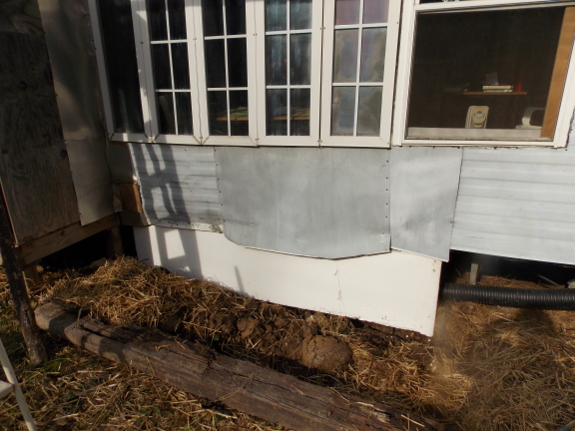
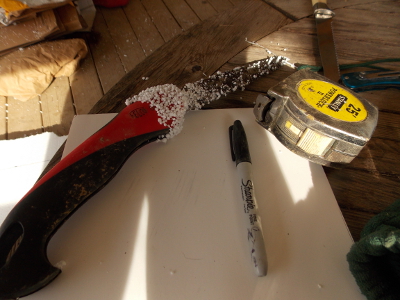 I left you hanging in yesterday's post
about our skirting decision, and while your thoughtful comments were
pouring in, I went outside to start experimenting. Mark had bought
me a four-foot-by-eight-foot-by-two-inch sheet of rigid-foam
insulation, unfaced because we wanted to buy from our local hardware
store (even though the options there are rather limited) rather than
driving an hour to Lowes. It turned out to be simple to cut the
insulation sheet to size with our hand saw
(much easier than using the utility knife I tried first). Digging
out a little bit of dirt where the insulation was going to go made it
relatively easy to slide the cut pieces into place.
I left you hanging in yesterday's post
about our skirting decision, and while your thoughtful comments were
pouring in, I went outside to start experimenting. Mark had bought
me a four-foot-by-eight-foot-by-two-inch sheet of rigid-foam
insulation, unfaced because we wanted to buy from our local hardware
store (even though the options there are rather limited) rather than
driving an hour to Lowes. It turned out to be simple to cut the
insulation sheet to size with our hand saw
(much easier than using the utility knife I tried first). Digging
out a little bit of dirt where the insulation was going to go made it
relatively easy to slide the cut pieces into place.
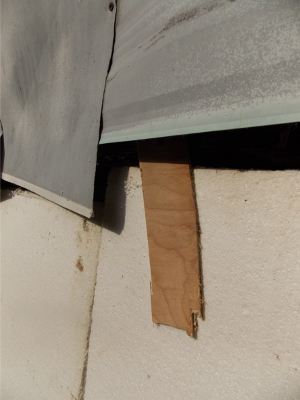 From
my perusal of the internet before beginning, I'd thought I'd need to
make a bottom rail for the insulation to attach to and to use button
nails to attach the top of the insulation to the underside of the
trailer. But once I got the insulation wedged into place, it
became clear it wasn't going anywhere, so I skipped that step. I
did use a bit of scrap wood to push one piece back so it lined up with
the other, though.
From
my perusal of the internet before beginning, I'd thought I'd need to
make a bottom rail for the insulation to attach to and to use button
nails to attach the top of the insulation to the underside of the
trailer. But once I got the insulation wedged into place, it
became clear it wasn't going anywhere, so I skipped that step. I
did use a bit of scrap wood to push one piece back so it lined up with
the other, though.
The corrugated pipe we're using to send water from our (as-yet-hypothetical) downspout to our greywater wetland
goes under the trailer, and I'd originally planned to cut a hole in the
insulation to let the pipe through. But as I worked, I figured it
would be simpler to dig down a bit and send the pipe underneath (as you
can see in the photo below). As I type this, though, I'm
wondering if that's a good idea, since the pipe will go down and then
slightly up, meaning a bit of water will pool in the lowest point and
will probably freeze in the winter. I guess we'll wait and see if
that's an issue, or maybe I'll fix the problem before Mark installs the
downspout.
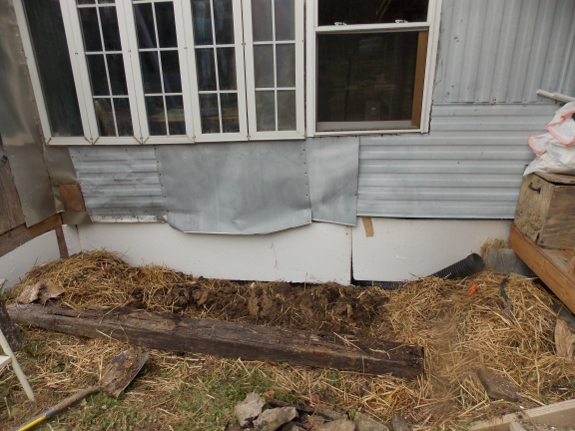
You'll notice there are a
few small cracks between the sheets of foam in the photo above. I
went back and forth on these, at first thinking I'd seal them with
reflective tape, but then realizing that the flashing I planned on
putting on the outside would do the same job. When I finally crawl
underneath to deal with the problematic insulation under the floor (one
of these days...), I may use some spray-foam insulation to fill in
these gaps.
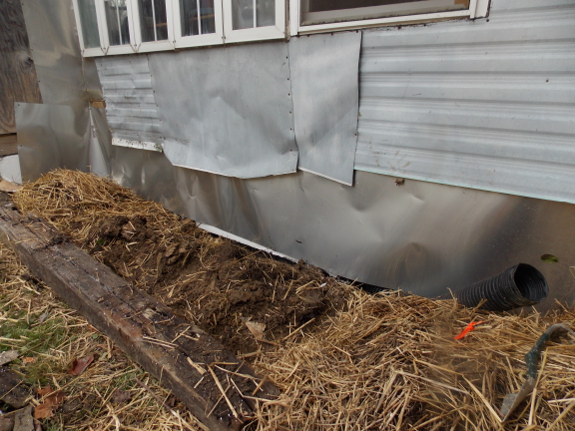
Rigid-foam insulation
isn't supposed to deal well with either UV damage or water, so it needs
some kind of outer layer. We could have bought skirting made for
trailers, but flashing is so easy to work with (and is always on hand),
so I decided to give that a try instead. After I took this photo, I
backfilled some earth around the base (and will add even more dirt
later to increase the height of the planting bed), so the gap at the
bottom shown in the photo above is already long gone.
This small part of the
skirting project was so fun and easy, it made me wonder why we've been
putting off skirting for so long. Then I remembered that I want to
replace the disintegrating insulation under the trailer floor before we
make it even harder to work under there by closing the space in.
We may need to bite the bullet and do that before summer, though, since
the back of the insulation sheets I installed this week are currently
exposed under the trailer, and free-range chicks adore pecking at
styrofoam....
Want more in-depth information? Browse through our books.
Or explore more posts by date or by subject.
About us: Anna Hess and Mark Hamilton spent over a decade living self-sufficiently in the mountains of Virginia before moving north to start over from scratch in the foothills of Ohio. They've experimented with permaculture, no-till gardening, trailersteading, home-based microbusinesses and much more, writing about their adventures in both blogs and books.
Want to be notified when new comments are posted on this page? Click on the RSS button after you add a comment to subscribe to the comment feed, or simply check the box beside "email replies to me" while writing your comment.

I recall seeing folk use straw bales around the base up home in Minnesota, but I'd think that would attract mice and rats. However in that climate your pipes would easily freeze in the sub zero temps for extended times without anything.
And on the subject of using local material, I can totally understand that. I am guessing the Lowe's in Wise would be an hour trip for you.